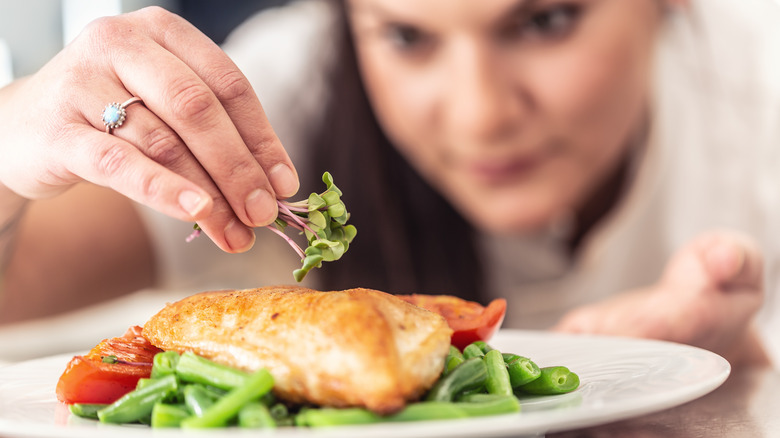How Unhealthy Is Chicken Skin?
Chicken skin has a rather bad reputation for being high in fat and cholesterol. A 3.5-ounce serving provides around 450 calories, 20 grams of protein, and 40 grams of fat, according to Nutrition Value. You'll also get 8% of the daily recommended iron intake and small amounts of iron, calcium, and potassium, plus 82 grams of cholesterol. Skinless chicken breast, by comparison, delivers 110 calories, 23 grams of lean protein, 1.24 grams of fat, and 58 milligrams of cholesterol per 3.5 ounces. These figures indicate that chicken skin isn't particularly high in dietary cholesterol.
Chicken skin is also flavorful. "For the most part, I always cook chicken with the skin on," chef Ina Garten revealed on her website. "I find it makes the meat much more tender and moist." But just how unhealthy is chicken skin, and should you remove it? Let's take a look at what the research says.
The truth about chicken skin
As you probably know, not all fats are created equal. Chicken skin contains mostly unsaturated fats, according to University Hospitals. It's particularly high in monounsaturated fatty acids, such as those found in olive oil. These dietary fats may help improve blood lipids and heart health, notes Harvard Medical School. Omega-3s, omega-6s, and other polyunsaturated fatty acids are just as beneficial.
The crispy skin of a well-cooked chicken also supplies small amounts of saturated fat. Harvard Medical School explains that saturated fat may not be as harmful as it was once thought. While some studies suggest that it may increase heart disease risk, more recent research shows that there's not enough evidence in this regard. One meta-analysis published in the American Journal of Clinical Nutrition points out that saturated fat intake doesn't increase the risk of heart or stroke.
Also, note that chicken skin isn't significantly higher in cholesterol than most types of meat. As mentioned earlier, it has only 3.5 grams of cholesterol per serving (3.5 ounces). Dietary cholesterol doesn't affect blood cholesterol levels in healthy people. "Your genetic makeup — not diet — is the driving force behind cholesterol levels," cardiologist Steven Nissen told the Cleveland Clinic.
Enjoy it in moderation to reap the benefits
Rich in protein and healthy fats, chicken skin is a better choice than processed meats and fast food. However, you still need to watch your portions. First of all, fat has more than double the number of calories of protein or carbs. One gram of dietary fat, regardless of its type, provides 9 calories. Protein and carbohydrates, on the other hand, supply 4 calories per gram (via USDA).
How you cook the chicken matters, too. Frying increases the fat content of food, adding necessary calories to your diet. Moreover, fried foods can increase your risk of heart disease, diabetes, obesity, and other ailments, warns WebMD. For example, 3.5 ounces of fried skin-on chicken breast has around 268 calories, 17 grams of fat, and 8.5 grams of carbs, depending on the recipe. Roasted skin-on chicken breast, by comparison, provides 165 calories, 3.6 grams of fat, and zero carbs, according to My Food Data.
All in all, it's perfectly fine to eat chicken skin as long as you don't go overboard. Pay attention to serving sizes and roast, bake, or boil the meat rather than frying it. "The healthiest way to cook chicken is to poach it," registered dietitian Rebecca Lewis told Women's Health. Grilled chicken is a good choice too, notes Lewis. Sauces and dips can significantly increase the calorie count, so you might want to avoid them. Use fresh or dried herbs and spices, such as ginger or turmeric, for extra flavor.



